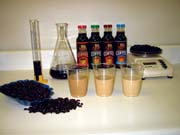
To learn more about coffee ingredients that have application in dairy foods, particularly milk, Dairy Foods magazine interviewed Greg Ryan, pres. and CEO, Ryan Coffee Co., San Leandro, Calif., a coffee company founded in 1990 that has been selling coffee ingredients since 2002.
DF: Coffee is a popular flavor in dairy products such as ice cream and milk beverages. But there are so many coffee ingredients to choose from. How do I narrow down what form and flavor will work best in my product?
GR: Cost is always a consideration when formulating any product. The cheapest coffee flavor, measured as a single ingredient, is a freeze-dried or powdered coffee flavor. An advantage is that it can be diluted to whatever strength is required. The downside is that such products deliver an acidic or bitter aftertaste, and a formulator needs to mask the bitterness, especially in cold beverages, with other flavors, thickeners or sweeteners.
DF: What are the forms that coffee ingredients come in, and what are the advantages and disadvantages of using them in dairy products?
GR: In addition to the aforementioned coffee ingredients, artificial coffee flavors are also popular. These are the result of lab wizardry, which try to mimic the flavor of coffee. They are usually very cost-effective. An advantage is that it only takes a small amount to create or enhance the taste of coffee in food products. The downside is that they can seldom be used by themselves, which complicates the recipe and a growing number of consumers don't like or appreciate artificial flavors or colors.
Another popular group of coffee flavors are the extracts, which are available in a wide range of qualities with accompanying costs. The most common method of preparation is to brew gallons of coffee in the usual manner, and then reduce the amount of water in the brew with additional heat. An advantage of extracts is that you can choose from a wide variety of tastes and strengths. The downside is that the brew has been heated multiple times, which brings out the acidic and bitter compounds in the coffee. This often makes it difficult to create a product, especially a cultured dairy product, with a smooth taste and finish.

Although similar in form to extracts, the method in which concentrates are produced makes them very different. Concentrates are typically brewed at low temperatures, and with much less water, as compared to extracts, which have quite a bit of water that is boiled off to form a reduction. Since it is "brewed" only once, the process delivers a taste advantage in that it is smoother to begin with and the ensuing sterilization or pasteurization process does not create bitter or acidic aftertastes that need masking.
One of the reasons we've achieved our robust market share in a relatively short period of time is because our concentrates are cold-brewed, which means they don't break down into acidic components during aseptic processing. It's the acids and tannins produced from freeze-dried powders and extracts during pasteurization and sterilization that result in bitter after notes. Our proprietary cold-brewing process leaves those components in the grounds and not in the flavor concentrates we ship to customers.
DF: I want to be as creative as possible with my new coffee-milk line. What are some flavor combination ideas that you have?
GR: A number of our customers have been surprised at how popular coffee-flavored milks have become in their beverage line. In fact, for some customers, coffee-flavored milk is close behind in sales to chocolate-flavored milk. A good recipe to follow is Starbucks Frappuccino. The base is a robust, but smooth coffee ingredient that leaves no aftertaste. Another popular flavor is a mocha coffee milk. The recipe is simple-a little chocolate added to a smooth coffee component. For market success, a formulator would need to stay away from the sweet chocolate flavors that appeal most to youngsters.
For more information on Ryan Coffee's coffee concentrates, call 800/452-8331, or visit www.ryancoffee.com.



